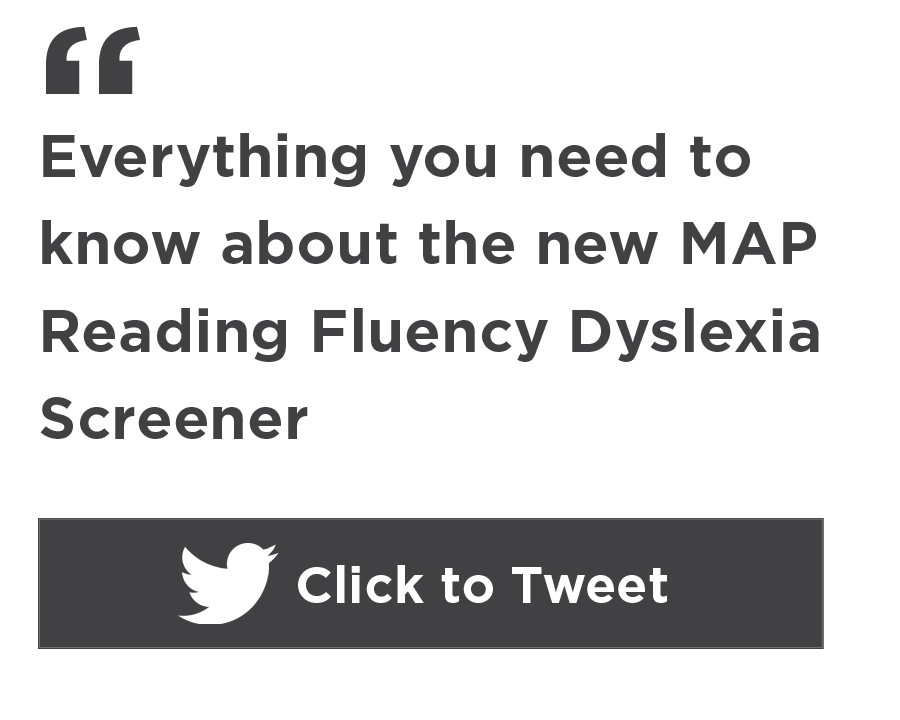Since 2018, MAP® Reading Fluency™ has made it easier for teachers to understand their students’ reading skills so they can spend more time teaching and less time testing. By assessing the critical components of early reading—oral reading fluency, literal comprehension, and foundational skills—it provides a more complete picture of a student’s reading ability in 20 minutes or less. The automatic scoring and group administration (remote or in person) have saved teachers a ton of time, too. Together the robust data and extra time help teachers confidently plan instruction and support each student in their learning-to-read journey.
Beginning in fall 2021, educators will be able to do one more very important thing with MAP Reading Fluency: screen K–3 students for characteristics of dyslexia or other reading difficulties.
Here are the five most important things you need to know about the new MAP Reading Fluency Dyslexia Screener.
1. Our new screener brings the best of MAP Reading Fluency to dyslexia screening
Built on the foundation of MAP Reading Fluency, the new dyslexia screener leverages the same innovative technology to keep saving teachers time with group administration, automatic scoring, and objective results in easy-to-read reports.
Following the screener’s release in fall 2021, teachers will be able to use MAP Reading Fluency just as they always have: as a pre-K–5 early reading benchmark assessment and progress monitoring tool. And in contrast to other dyslexia screeners, which require 1:1 administration, educators will now have an option that can be used with an entire class at once.
2. The screener applies a predictive model to flag student results
The dyslexia screener reporting features a predictive flag to help educators quickly and clearly see students whose results suggest that follow-up is appropriate.
What does the flag mean, exactly? The screener uses several measures from the foundational skills domain to identify students whose results may indicate possible characteristics of dyslexia or other reading difficulties. The flag is based on a psychometrically backed predictive model and the likelihood of later reading difficulties. It is not a diagnosis of dyslexia or of a reading disability.
For any flagged student, an educator with training in dyslexia can study the rapid automatized naming (RAN) data in conjunction with the foundational skills data from the screener to determine next steps.
3. Key data informs instruction
In addition to the predictive flag and RAN measure, teachers will also receive informative foundational skills reporting for each student assessed with the dyslexia screener test form. That means there is no need to double test for skill-level instructional planning.
The dyslexia screener reporting will highlight each student’s zone of proximal development (ZPD) in the progression of phonological awareness skills, as well as phonics and word recognition skills. This will help teachers better understand what instructional support or interventions may be appropriate. Each student report will also link to resources from the Florida Center for Reading Research with activities tailored to their skill needs and ZPD.
4. The screener is a screener only, not a diagnostic tool
The MAP Reading Fluency Dyslexia Screener is just that, a screener. It is brief and universal, so it can be used for all students, and it is designed to identify students who may need follow-up, including possible evaluation with a diagnostic tool. A diagnostic tool provides a much deeper dive for the subset of students flagged as at risk for reading difficulty, and it focuses on the why and how of a student’s struggles. For dyslexia in particular, screener follow-up processes, protocols, or next steps may look different from district to district and state to state.
Think of it this way: The dyslexia screener is akin to a vision screening, where a child is asked to read letters on a chart a few feet away. If they have trouble, they move on to more in-depth screening with an optometrist, who might determine their diagnosis is nearsightedness and prescribe glasses.
5. All MAP Reading Fluency partners will have access to the dyslexia screener beginning in fall 2021
The dyslexia screener represents a major expansion to MAP Reading Fluency and we are excited to include it for our partners at no additional charge. The new screener solution will be available to all partners as part of their MAP Reading Fluency license.
Learn more about meeting the needs of kids with dyslexia
According to the International Dyslexia Association (IDA), about 15–20% of people in the US have some characteristics of dyslexia, like trouble with accurate reading, fluent word recognition, spelling, or decoding. Learn more about how dyslexia may affect your students—and what you can do about it—with the following Teach. Learn. Grow. posts:
- “Fact or fiction? The 4 myths of dyslexia”
- “Why students with dyslexia aren’t ‘at risk’”
- “5 tips for supporting students with dyslexia during COVID-19”
- “The case for K–3 screening and intervention for dyslexia”
Reach out to your account manager to learn more about the MAP Reading Fluency Dyslexia Screener, or contact us for information about bringing MAP Reading Fluency on in your school or district.









